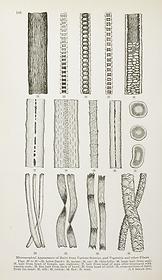Exhibition Images
Image 13 of 30
Laboratory Views
Illustrations of hair under a microscope, 1894
"The presence upon weapons or the clothing of a defendant of hairs from animals or of various fibers used in the manufacture of textile fabrics has in numerous cases proved to be of great importance in trials for homicide�. Hairs found upon weapons or clothing may be from the head or other parts of the human body, or from some domestic animal. ...Fibers may be of silk, wool, cotton, linen, or a mixture of these in the various kinds of fabrics employed for clothing. The identification of hairs and fibers is, in most cases, conclusive and satisfactory-i.e., it can be asserted with certainty that a given hair is human or from some animal, and in most cases the animal, or at least, the class to which it belongs, can be determined. The diameters, length, and peculiar markings of hair when observed in the microscope furnish the means for distinguishing them."
--James F. Babcock, "Hairs and Fibers," in Hamilton & Godkin,A System of Legal Medicine (New York, 1894), 187.
--James F. Babcock, "Hairs and Fibers," in Hamilton & Godkin,A System of Legal Medicine (New York, 1894), 187.
Allan McLane Hamilton and Lawrence Godkin, A System of Legal Medicine, New York, 1894
National Library of Medicine
